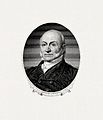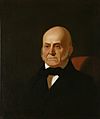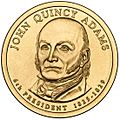John Quincy Adams facts for kids
{{Infobox officeholder | name = John Quincy Adams | image = JQA Photo.tif | caption = Adams in the 1840s. Photo portrait by Mathew Brady | office = 6th President of the United States | vicepresident = John C. Calhoun | term_start = March 4, 1825 | term_end = March 4, 1829 | predecessor = James Monroe | successor = Andrew Jackson | office1 = 8th United States Secretary of State | president1 = James Monroe | term_start1 = September 22, 1817 | term_end1 = March 4, 1825 | predecessor1 = James Monroe | successor1 = Henry Clay | jr/sr2 = United States Senator | state2 = Massachusetts | term_start2 = March 4, 1803 | term_end2 = June 8, 1808 | predecessor2 = Jonathan Mason | successor2 = James Lloyd | office3 = Member of the United States
House of Representatives
from Massachusetts | term_start3 = March 4, 1831 | term_end3 = February 23, 1848 | predecessor3 = Joseph Richardson | successor3 = Horace Mann | constituency3 = 11th district (1831–33)
12th district (1833–43)
8th district (1843–48)
| module =
John Quincy Adams (July 11, 1767 – February 23, 1848) was the sixth President of the United States. He was the first president who was the son of a president. He was also the first president to be photographed instead of painted.
Adams was a member of the Federalist Party and worked for all the presidents before him. He was the United States Secretary of State for James Monroe, who was president before him. Adams started his career early. At just 27, in 1794, President George Washington made him the U.S. Minister to the Netherlands.
Later in his life, Adams became a strong voice against slavery. In 1838, when he was 71, he spoke up for the African slaves from the ship Amistad. He won their case, helping them gain freedom. He also fought against the "Gag Rule" in Congress, which tried to stop discussions about slavery. After an eight-year struggle, he helped get rid of this rule in 1844.
Contents
|
|||||||||||||||||||||||||||||||||||||||||||||
| Personal details | |||||||||||||||||||||||||||||||||||||||||||||
|---|---|---|---|---|---|---|---|---|---|---|---|---|---|---|---|---|---|---|---|---|---|---|---|---|---|---|---|---|---|---|---|---|---|---|---|---|---|---|---|---|---|---|---|---|---|
| Born | July 11, 1767 Braintree, Massachusetts Bay, British America |
||||||||||||||||||||||||||||||||||||||||||||
| Died | February 23, 1848 (aged 80) Washington, D.C., U.S. |
||||||||||||||||||||||||||||||||||||||||||||
| Resting place | United First Parish Church | ||||||||||||||||||||||||||||||||||||||||||||
| Political party | Federalist (1792–1808) Democratic-Republican (1809–28) National Republican (1828–30) Anti-Masonic (1830–34) Whig (1834–48) |
||||||||||||||||||||||||||||||||||||||||||||
| Spouse | |||||||||||||||||||||||||||||||||||||||||||||
| Children | George John Charles Louisa |
||||||||||||||||||||||||||||||||||||||||||||
| Parents | John Adams Abigail Smith |
||||||||||||||||||||||||||||||||||||||||||||
| Relatives | See Adams political family and Quincy political family | ||||||||||||||||||||||||||||||||||||||||||||
| Education | Harvard University (BA, MA) | ||||||||||||||||||||||||||||||||||||||||||||
| Signature | |||||||||||||||||||||||||||||||||||||||||||||
- Later Life and Death
- Famous Quotes by John Quincy Adams
- Interesting Facts About John Quincy Adams
- Images for kids
- See also
Early Life and Education
John Quincy Adams was born in 1767 in Braintree, Massachusetts. As a child, he watched the Battle of Bunker Hill, an important fight in the American Revolutionary War, from his family's farm.
When his father, John Adams, traveled to Europe, young John Quincy went with him as his secretary. This helped him become very good at speaking other languages. Besides English, he could speak Latin and French fluently. He also knew some Dutch, German, Greek, Italian, Spanish, and Russian.
He went to Harvard University and became a lawyer. At age 26, he was appointed as a diplomat to the Netherlands, and then he went to Berlin. In 1802, he was elected to the United States Senate. Six years later, President James Madison appointed him as a diplomat to Russia.
As Secretary of State when James Monroe was President, Adams helped the U.S. gain joint control of Oregon with the United Kingdom. He also helped get Florida from Spain. He played a key role in creating the Monroe Doctrine, a policy that warned European countries not to interfere in the Americas.
Presidency of John Quincy Adams
John Quincy Adams became President of the United States in 1824. This election was unusual because none of the five candidates won enough electoral votes to become president directly. So, the U.S. House of Representatives had to choose the winner. Andrew Jackson had the most votes, but not enough to win outright. The House chose Adams.
After becoming president, Adams made one of his opponents, Henry Clay, his Secretary of State.
The American System
As president, Adams wanted to improve the United States through what he called the "American System." He planned to build new roads and canals across the country. To pay for these projects, he used high tariffs, which are taxes on imported goods.
Adams also wanted to create a national university, a naval academy, and a national observatory. He supported having a national bank, but many people, especially supporters of Andrew Jackson, did not like this idea.
Adams lost the 1828 election to Andrew Jackson. That election was known for the many personal attacks the candidates made against each other.
Fighting Against Slavery
In the 1830s, the issue of slavery in the United States became a major national topic. People across the country took strong sides. John Quincy Adams was strongly against slavery and used his position in Congress to fight it.
The Gag Rule
By 1836, many members of the House of Representatives were tired of Adams presenting petitions from citizens asking to end slavery in Washington, D.C. So, they created a "Gag Rule." This rule meant that any petitions about slavery were put aside and could not be discussed. This rule was supported by Democrats and Southern Whigs but opposed by most Northern Whigs, like Adams.
In late 1836, Adams began to openly criticize slave owners and the gag rule. He kept trying to present anti-slavery petitions in Congress, which often upset Southern representatives. Even though the gag rule stayed in place for a while, his constant fight against slavery brought up important questions. These questions included: the right of citizens to petition the government, the right to debate laws in Congress, and whether slavery was morally right. Adams continued his fight and finally saw the gag rule removed in 1844.
The Amistad Case
In 1841, Adams took on a very important case called United States v. The Amistad. He was asked by Lewis Tappan and Ellis Gray Loring to defend a group of African slaves. These slaves had revolted on a Spanish slave ship called The Amistad. They took control of the ship that was bringing them to America to be sold.
Adams spoke in front of the Supreme Court for four hours on February 24, 1841. His powerful argument worked! The Court decided in favor of the Africans, declaring them free. They were then able to return to their homes.
Later Life and Death
After his presidency, Adams returned to Washington D.C. In 1831, he was elected to the United States House of Representatives. He became a leading opponent of slavery. He continued to serve in Congress until his death on February 23, 1848.
On February 21, 1848, Adams suffered a stroke in the House chamber. He collapsed and died in the House two days later, on February 23, 1848. He was eighty years old.
Famous Quotes by John Quincy Adams
- “Always vote for principle, though you may vote alone.”
- “If your actions inspire others to dream more, learn more, do more, and become more, you are a leader.”
- “Try and fail, but don't fail to try.”
- “Posterity -- you will never know how much it has cost my generation to preserve your freedom. I hope you will make good use of it.”
- “If the fundamental principles in the Declaration of Independence, as self-evident truths, are real truths, the existence of slavery, in any form, is a wrong.”
Interesting Facts About John Quincy Adams
- His father was the second President of the United States.
- John Quincy Adams spent his entire adult life in politics, right up until the day he died.
- He served in many different roles for the United States under all the presidents who came before him.
- He became the sixth President of the United States and was the first to be chosen by the House of Representatives.
- John Quincy Adams was strongly against slavery and used his experience in government to try to abolish (get rid of) it.
Images for kids
-
Adams's birthplace in Quincy, Massachusetts
-
Adams portrait – Gilbert Stuart, 1818
-
Painting of John Quincy Adams by Thomas Sully, 1824
-
In the Adams–Onís Treaty, the United States acquired Florida and set the western border of the 1803 Louisiana Purchase.
-
Quincy Adams appointed Henry Clay as Secretary of State
-
BEP engraved portrait of Adams as president
-
Adams's portrait at the U.S. National Portrait Gallery by George Bingham c. 1850 copy of an 1844 original
-
Adams's cenotaph at the Congressional Cemetery
-
John Quincy Adams's original tomb at Hancock Cemetery, across the street from United First Parish Church
-
Presidential Dollar of John Quincy Adams
-
Official portrait of Adams by George Peter Alexander Healy, c. 1858
-
Tombs of Presidents John Adams (far left) and John Quincy Adams (right) and their wives Abigail and Louisa, in a family crypt beneath the United First Parish Church.
See also
 In Spanish: John Quincy Adams para niños
In Spanish: John Quincy Adams para niños



















